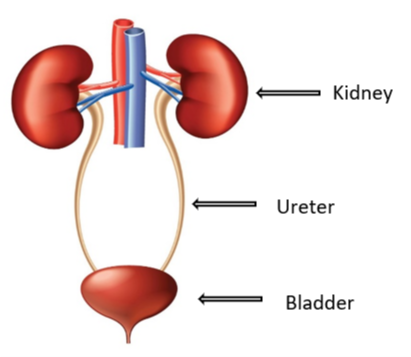What Would Cause a Little Boys Pee Pee Be Super Red When Pealed Back?
By: Darcy Weidemann, MD, FAAP & Nazia Kulsum-Mecci MD
It is not uncommon for children to sometimes have blood in their urine (pee). Sometimes, it can change the color of the urine. Blood in a child's urine can have different causes, many of which go away on their own or are easily treated.
What is hematuria?

Blood in the urine is called hematuria. Microscopic hematuria is when the urine looks normal in the toilet or a cup, but blood can be seen when looking at the urine with a microscope. Gross hematuria is when blood can be seen in the toilet or in a cup. The urine may look pink, red, or the color of tea or cola.
Blood in urine can come from anywhere in the urinary tract. Blood may come from the kidneys, the ureters (tubes that connect the kidneys to the bladder), the bladder (where urine is stored), or the urethra (the tube from the bladder to the outside of the body). Many healthy children have microscopic hematuria that goes away in a few weeks.
| Keep in mind: dark or red-colored urine does not always mean there is blood in the urine. Sometimes, certain medications or food colorings can cause the urine color to change. But it is important to talk with your pediatrician if you aren't sure of the cause. |
|---|
What causes hematuria?
Causes of hematuria in children include:
-
Vigorous exercise
-
Urinary tract infections
-
High calcium levels in the urine (called hypercalciuria)
-
Kidney stones
-
Trauma or injury
-
Structural problems or blockage in the urinary tract
-
Genetic conditions
-
Inflammatory kidney disease (glomerulonephritis)
-
Cancer (very rare)
What tests might be done?
Some or all of the below tests may be done in cases of hematuria, depending on what symptoms your child has:
-
Urine dipstick. This is usually done in your doctor's office. It can test for hematuria. Sometimes, the test results may be wrong, so the presence of actual red blood cells in the urine must be confirmed by looking at the urine with a microscope.
-
Renal and bladder ultrasound. This looks for cysts, kidney stones, tumors, and many other causes of hematuria.
-
Urine culture. This test looks for urinary tract infection.
-
Serum creatinine. This blood test checks how well the kidneys are working.
-
Complete blood count (CBC). This blood test checks for anemia (not enough red blood cells) and evidence of infection (increased white blood cell count).
-
Complement proteins. This blood test helps diagnose some causes of kidney disease called glomerulonephritis (inflammation of the kidney).
-
Urine calcium. This test checks for high levels of calcium in the urine. High urine calcium can result in kidney stones or blood in the urine even in the absence of stones.
-
Urine protein. This test can sometimes help distinguish between hematuria that is caused by the kidney itself or from the piping of the urinary tract (ureters, bladder, urethra). Persistent protein in the urine along with hematuria sometimes suggests a problem with the kidneys.
-
Kidney biopsy. This test is needed when the doctor thinks there may be damage to the filters of the kidneys. A kidney biopsy is performed in the hospital. The child is first put to sleep with medication. A needle is then used to take a small sample of kidney tissue. Most children with blood in the urine do not need this test.
-
Cystoscopy. This test looks for bleeding from the ureter, bladder, or urethra. It is uncommon for children to need cystoscopy. For this test, the doctor (a pediatric urologist) inserts a narrow tube with a tiny camera at the end of it to look at the bladder and urethra for the cause of the hematuria.
What treatment options are there?
Treatment depends on what is causing the hematuria. Often times, no treatment is needed. Infections are treated with antibiotics. If there is a high level of calcium in the urine, diet changes may be recommended such as low salt in food and drinking more water. Sometimes, medication may also be prescribed to help lower calcium levels in the urine.
In patients with glomerulonephritis, treatment includes medications such as steroids or other stronger medications that decrease inflammation in the kidney. In some children, medication is also given to control high blood pressure.
Kidney stones do not always require treatment, but may need to be removed if they are causing pain or infections. If your child is forming kidney stones, they may need additional urine and/or blood testing to help prevent future stones.
In about 1 out of 4 cases, doctors may not be able to find the cause for the hematuria. If all tests are normal and blood remains in the urine, yearly checkups are recommended to make sure the patient does not begin to develop kidney disease.
When should I contact the doctor?
-
If your child continues to have blood in the urine and/or has urinary symptoms (such as peeing very frequently, having pain while peeing, or having pain in the belly, back or side)
-
If there is fever, side or back pain
-
If your child is getting swollen and seems to be urinating less
-
If your child is unusually irritable, is having frequent headaches, or has decreased energy
-
If there are other symptoms like joint pain or a rash
More Information
- What is a Pediatric Nephrologist?
The information contained on this Web site should not be used as a substitute for the medical care and advice of your pediatrician. There may be variations in treatment that your pediatrician may recommend based on individual facts and circumstances.
What Would Cause a Little Boys Pee Pee Be Super Red When Pealed Back?
Source: https://www.healthychildren.org/English/health-issues/conditions/genitourinary-tract/Pages/Blood-in-Urine-Hematuria.aspx
0 Response to "What Would Cause a Little Boys Pee Pee Be Super Red When Pealed Back?"
Post a Comment